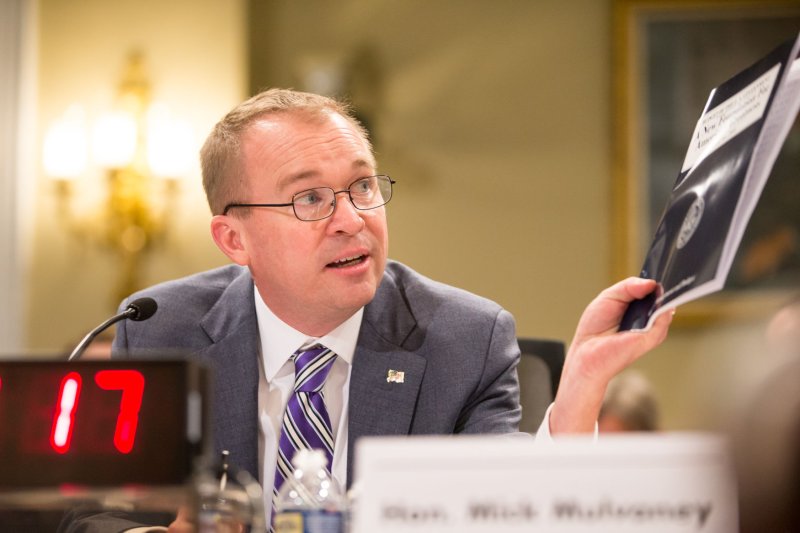1 of 7 | Office of Management and Budget Director Mick Mulvaney holds up a copy of President Donald Trump's budget proposal before the House Budget Committee on Wednesday. The plan proposes steep cuts in overall government spending and promises to balance the budget within 10 years. Photo by Erin Schaff/UPI |
License Photo
May 24 (UPI) -- President Donald Trump's budget director spent Wednesday on Capitol Hill defending the administration's proposed 2018 spending cuts, which seek to free up trillions of dollars and ax 66 federal programs.
Office of Budget Management Director Mick Mulvaney appeared before the House Budget Committee on Wednesday, where he was peppered with questions about what the president's pitch involves and why it's needed.
The biggest cuts in Trump's budget proposal remove $5 billion in education spending, $4.8 billion in health, $4.2 billion from the State Department and USAID, $4.1 billion in housing and $1.6 billion in federal efforts to fight climate change. The eliminated programs amount to nearly $27 billion.
All told, the recommendation -- titled "A New Foundation for American Greatness" -- would purge more than $3.5 trillion in federal spending over 10 years.
In his testimony Wednesday, Mulvaney defended the president's proposal as conscientious government spending.
"Can we justify this to the folks who are actually paying for it?" he asked the committee about the programs Trump's budget seeks to eliminate. "I don't think people are willing to pay for as much government as they are."
Mulvaney, whose job is to produce the executive branch's budget recommendations and evaluate financial efficiency of federal programs, is one of four top administration officials who were scheduled to testify about the president's budget pitch before the committee Wednesday. Treasury Secretary Steve Mnuchin, Education Secretary Betsy DeVos and Agriculture Secretary Sonny Perdue were the others.
Trump's plan aims for 3 percent economic growth, much faster than the economy has grown recently. That robust rate would balance the budget over the next 10 years, a strategy that some in Congress have questioned.
"If we don't get to 3 percent growth, it's unlikely we'll ever get a balanced budget again," Mulvaney said, classifying skeptics as "pessimistic."
"If that's where you are, don't accept it. Three percent growth is not something we should talk about, but something that should drive everything."
Mulvaney's chief critic at Wednesday's hearing was conservative Rep. Mark Sanford, R-S.C., a deficit hawk who said Trump's vision makes a great deal of economic assumptions.
"This budget assumes a 'Goldilocks' economy," Sanford said. "And I think that's a very difficult thing. It assumes that the stars perfectly align with regard to economic drivers."
Several other lawmakers concurred with Sanford's outlook, while Mulvaney said he was "stunned" that some feel the goal of achieving and maintaining 3 percent growth is too lofty.
Democrats also took aim at proposed cuts to social programs.
Rep. Pramila Jayapal, D-Wash., called Trump's aim to cut funding for welfare and disability assistance are "astonishing" and "immoral."
"This is a moral document and here's the moral side -- If I take money from you and have no intention of ever giving it back, that's not debt, that's theft," Mulvaney replied. "We don't want to measure compassion by the number of programs we have and the number of people on them. True compassion is the number of people we want to try to get off of those programs."
Trump's budget cuts, which are only recommendations to Congress, would impose steep cuts to the education, health, agriculture, state, treasury and commerce departments, as well as the Environmental Protection Agency and other federal offices. By contrast, the plan seeks far fewer reductions in the departments of homeland security, interior and justice -- and accompanies major increases in defense spending.
In addition to the widespread cuts, the budget also contains a rather large accounting mistake.
Based on 3 percent growth, Trump's budget identifies about $2 trillion in extra federal revenue over the next decade -- money it uses twice for different purposes. The outline says the $2 trillion will pay for Trump's tax reform, while simultaneously saying that same money will be used to balance the budget.
The discrepancy has been assailed by lawmakers on both sides of the aisle, but Mulvaney said Wednesday it was intentional.
"I'm aware of the criticisms and would simply come back and say there's other places where we were probably overly conservative in our accounting," he said. "We stand by the numbers."
Mnuchin seemed to acknowledge the mistake, saying the budget proposal is in an early stage and still needs to be refined.
Trump administration critics were not as forgiving.
"It appears to be the most egregious accounting error in a presidential budget in the nearly 40 years I have been tracking them," Larry Summers, former treasury chief under President Bill Clinton, said Wednesday.
"How could the Secretary of Treasury, Director of OMB and Director of the National Economic Council allow such an elementary error?"















